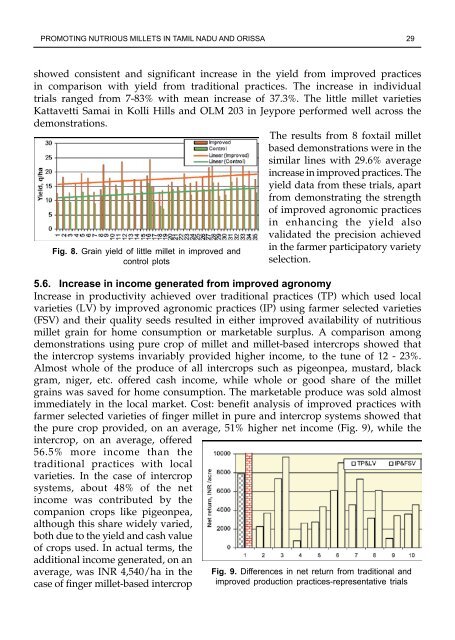Minor millets in South Asia: learnings from IFAD-NUS project in India ...
Minor millets in South Asia: learnings from IFAD-NUS project in India ...
Minor millets in South Asia: learnings from IFAD-NUS project in India ...
Create successful ePaper yourself
Turn your PDF publications into a flip-book with our unique Google optimized e-Paper software.
promot<strong>in</strong>g nutrious <strong>millets</strong> <strong>in</strong> tamil nadu and orissa 29<br />
showed consistent and significant <strong>in</strong>crease <strong>in</strong> the yield <strong>from</strong> improved practices<br />
<strong>in</strong> comparison with yield <strong>from</strong> traditional practices. The <strong>in</strong>crease <strong>in</strong> <strong>in</strong>dividual<br />
trials ranged <strong>from</strong> 7-83% with mean <strong>in</strong>crease of 37.3%. The little millet varieties<br />
Kattavetti Samai <strong>in</strong> Kolli Hills and OLM 203 <strong>in</strong> Jeypore performed well across the<br />
demonstrations.<br />
The results <strong>from</strong> 8 foxtail millet<br />
based demonstrations were <strong>in</strong> the<br />
similar l<strong>in</strong>es with 29.6% average<br />
<strong>in</strong>crease <strong>in</strong> improved practices. The<br />
yield data <strong>from</strong> these trials, apart<br />
<strong>from</strong> demonstrat<strong>in</strong>g the strength<br />
of improved agronomic practices<br />
<strong>in</strong> enhanc<strong>in</strong>g the yield also<br />
validated the precision achieved<br />
Fig. 8. gra<strong>in</strong> yield of little millet <strong>in</strong> improved and<br />
control plots<br />
<strong>in</strong> the farmer participatory variety<br />
selection.<br />
5.6. Increase <strong>in</strong> <strong>in</strong>come generated <strong>from</strong> improved agronomy<br />
Increase <strong>in</strong> productivity achieved over traditional practices (TP) which used local<br />
varieties (LV) by improved agronomic practices (IP) us<strong>in</strong>g farmer selected varieties<br />
(FSV) and their quality seeds resulted <strong>in</strong> either improved availability of nutritious<br />
millet gra<strong>in</strong> for home consumption or marketable surplus. A comparison among<br />
demonstrations us<strong>in</strong>g pure crop of millet and millet-based <strong>in</strong>tercrops showed that<br />
the <strong>in</strong>tercrop systems <strong>in</strong>variably provided higher <strong>in</strong>come, to the tune of 12 - 23%.<br />
Almost whole of the produce of all <strong>in</strong>tercrops such as pigeonpea, mustard, black<br />
gram, niger, etc. offered cash <strong>in</strong>come, while whole or good share of the millet<br />
gra<strong>in</strong>s was saved for home consumption. The marketable produce was sold almost<br />
immediately <strong>in</strong> the local market. Cost: benefit analysis of improved practices with<br />
farmer selected varieties of f<strong>in</strong>ger millet <strong>in</strong> pure and <strong>in</strong>tercrop systems showed that<br />
the pure crop provided, on an average, 51% higher net <strong>in</strong>come (Fig. 9), while the<br />
<strong>in</strong>tercrop, on an average, offered<br />
56.5% more <strong>in</strong>come than the<br />
traditional practices with local<br />
varieties. In the case of <strong>in</strong>tercrop<br />
systems, about 48% of the net<br />
<strong>in</strong>come was contributed by the<br />
companion crops like pigeonpea,<br />
although this share widely varied,<br />
both due to the yield and cash value<br />
of crops used. In actual terms, the<br />
additional <strong>in</strong>come generated, on an<br />
average, was INR 4,540/ha <strong>in</strong> the<br />
case of f<strong>in</strong>ger millet-based <strong>in</strong>tercrop<br />
Fig. 9. differences <strong>in</strong> net return <strong>from</strong> traditional and<br />
improved production practices-representative trials

















